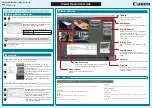
10-2
Catalyst 3550 Multilayer Switch Software Configuration Guide
78-11194-03
Chapter 10 Configuring STP
Understanding Basic STP Features
For information about advanced STP features, see the
“Understanding Advanced STP Features” section
on page 10-10
and the
“Configuring Advanced STP Features” section on page 10-32
.
Supported STP Instances
This software release supports the per-VLAN spanning tree (PVST) and a maximum of 128
spanning-tree instances. If more VLANs are defined in the VLAN Trunking Protocol (VTP) than
spanning-tree instances, you can enable STP on only 128 VLANs. The remaining VLANs operate with
STP disabled.
If 128 instances of spanning tree are already in use, you can disable STP on one of the VLANs and then
enable it on the VLAN where you want it to run. Use the no spanning-tree vlan vlan-id global
configuration command to disable STP on a specific VLAN, and use the spanning-tree vlan vlan-id
global configuration command to enable STP on the desired VLAN.
Caution
Switches that are not running spanning tree still forward BPDUs that they receive so that the other
switches on the VLAN that have a running spanning-tree instance can break loops. Therefore, STP
must be running on enough switches to break all the loops in the network; for example, at least one
switch on each loop in the VLAN must be running STP. It is not absolutely necessary to run STP on
all switches in the VLAN; however, if you are running STP only on a minimal set of switches, an
incautious change to the network that introduces another loop into the VLAN can result in a
broadcast storm.
Note
If you have already used all available spanning-tree instances on your switch, adding another VLAN
anywhere in the VTP domain creates a VLAN that is not running STP on that switch. If you have the
default allowed list on the trunk ports of that switch, the new VLAN is carried on all trunk ports.
Depending on the topology of the network, this could create a loop in the new VLAN that will not
be broken, particularly if there are several adjacent switches that have all run out of spanning-tree
instances. You can prevent this possibility by setting allowed lists on the trunk ports of switches that
have used up their allocation of spanning-tree instances. Setting up allowed lists is not necessary in
many cases and can make it more labor-intensive to add another VLAN to the network.
Spanning-tree commands determine the configuration of VLAN spanning-tree instances. You create a
spanning-tree instance when you assign an interface to a VLAN. The spanning-tree instance is removed
when the last interface is moved to another VLAN. You can configure switch and port parameters before
a spanning-tree instance is created; these parameters are applied when the spanning-tree instance is
created.
STP Overview
STP is a Layer 2 link management protocol that provides path redundancy while preventing undesirable
loops in the network. For a Layer 2 Ethernet network to function properly, only one active path can exist
between any two stations. STP operation is transparent to end stations, which cannot detect whether they
are connected to a single LAN segment or a switched LAN of multiple segments.
When you create fault-tolerant internetworks, you must have a loop-free path between all nodes in a
network. The spanning-tree algorithm calculates the best loop-free path throughout a switched Layer 2
network. Switches send and receive STP frames at regular intervals. The switches do not forward these
frames, but use the frames to construct a loop-free path.
















































